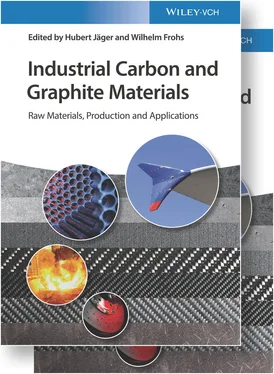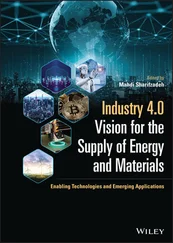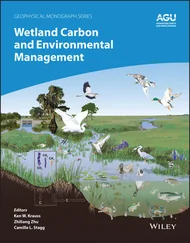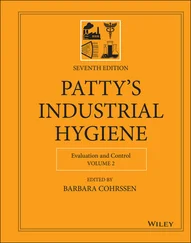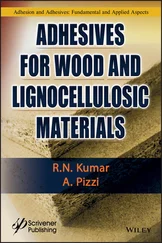25 Chapter 12-3Table 12.3.1 Properties of industrially produced C/SiC materials based on 2D and...Table 12.3.2 Typical properties of MI‐derived C/C–SiC and C/SiC materials based ...Table 12.3.3 Properties of MI‐derived C/SiC materials based on short fibers comp...
26 Chapter 13Table 13.1 Rodent study reports by the governmental evaluation of CNTs.
1 Chapter 1 Figure 1.1 Carbon materials and their market value. Figure 1.2 Development of the specific consumption of graphite electrodes. Figure 1.3 Graphite electrode producers and their production capacity (2018)... Figure 1.4 Blast furnace and EAF steel production. Figure 1.5 Graphite electrode. (a) Graphite electrode with crack in the join... Figure 1.6 Carbon electrodes with diameters up to 1400 mm. Figure 1.7 The demand for carbon electrodes. Figure 1.8 Carbon electrode producer and capacity. SGL: Since 2018 COBEX. Figure 1.9 Aluminum electrolysis cell. Figure 1.10 Cathode production by grade. Figure 1.11 Cathode producers and their capacity. SGL: Since 2018 COBEX. Figure 1.12 Increase in cell amperage over the last 70 years. Figure 1.13 Test assembling of a blast furnace lining. Figure 1.14 Hot metal production in blast furnaces. Figure 1.15 Blast furnace diameter. Figure 1.16 Silicon single crystal production. Figure 1.17 Demand for fine‐grained graphite. Figure 1.18 Fine‐grained graphite producer. Figure 1.19 Mechanical properties of carbon fibers. Figure 1.20 Carbon fiber fields of application. Figure 1.21 Carbon fiber demand and capacity. Figure 1.22 Carbon fiber producers and their estimated capacities. Figure 1.23 Energy and power density for different storage systems. Figure 1.24 Expected Li‐ion battery demand. Figure 1.25 Li‐ion anode material producer and their capacity. Figure 1.26 Fuel cell schematics. Figure 1.27 Fuel cell demand distribution by application. Figure 1.28 Gas diffusion layer production capacity. Figure 1.29 Redox flow battery production. Figure 1.30 Production capacities for redox flow batteries. Figure 1.31 Mechanical strength from carbon fibers to nanotubes.
2 Chapter 2 Figure 2.1 Relative abundance of elements in the Earth’s upper crust. Figure 2.2 Allotropic modifications of the element carbon. Figure 2.3 The four most important allotropic forms of the solid element car... Figure 2.4 Bonding hybridization and corresponding crystal structure of carb... Figure 2.5 CC bonds and the formation of hydrocarbons and extension to carb... Figure 2.6 Hydrogen content of various hydrocarbons and heat‐treated residue... Figure 2.7 Phase diagram of carbon.
3 Chapter 3 Figure 3.1 Siemens‐Plania factory “Schwarze Bude” at Ratibor (1928) [19,20].... Figure 3.2 Manufacture of lampblack in China (wood engraving 2630 BC).
4 Chapter 5 Figure 5.1 (a) Lattice of the cubic diamond and the hexagonal graphite cryst... Figure 5.2 X‐ray diffraction pattern of non‐graphitic and graphitic carbon m... Figure 5.3 (a) High‐resolution transmission electron microscopy (HR‐TEM) bri... Figure 5.4 AFM image of graphite. The hexagonal carbon rings are visible and... Figure 5.5 Scanning electron microscopy (SEM) picture of a flake natural gra... Figure 5.6 Classification of different forms of carbon according to IUPAC no... Figure 5.7 Gaseous, liquid, and solid pyrolysis and their products. Figure 5.8 Optical micrograph of carbonaceous mesophase from heated anthrace... Figure 5.9 Carbonaceous mesophase structure (a) and mechanism of growth by c... Figure 5.10 Reaction scheme for carbonization and graphitization. Figure 5.11 Structural development of a graphitizable carbon during heat tre...
5 Chapter 6-1-1 Figure 6.1.1.1 Production scheme for synthetic carbon and graphite materials... Figure 6.1.1.2 Sources for petroleum and coal‐tar pitch coke. Figure 6.1.1.3 Optical micrographs of petroleum needle coke (a), an anode‐gr... Figure 6.1.1.4 Development of the needle coke CTE [Method, DIN 51909]. Figure 6.1.1.5 Various coke types and their usages. Figure 6.1.1.6 Expansion of petroleum and coal‐tar pitch coke‐derived electr... Figure 6.1.1.7 Estimated petroleum and coal‐tar pitch needle coke capacities... Figure 6.1.1.8 World usage of pitch. Figure 6.1.1.9 Global coal‐tar production (CRU).
6 Chapter 6-1-2 Figure 6.1.2.1 Area petroleum coke production 2013 and production increase p... Figure 6.1.2.2 Flow sheet of delayed coking. (a) Fractionator. (b) Furnace. ... Figure 6.1.2.3 Photograph of a refining delayed coker complex: furnace, coke... Figure 6.1.2.4 Product yields with thermal conversion processes. Figure 6.1.2.5 Relationship between plant operating conditions and plant yie... Figure 6.1.2.6 Flow sheet of fluid coking. (a) Reactor. (b) Scrubber. (c) Bu... Figure 6.1.2.7 Flow sheet of flexicoking. (a) Reactor. (b) Scrubber. (c) Hea... Figure 6.1.2.8 Schematic of the rotary kiln calciner. (a) Screen. (b) Crushe... Figure 6.1.2.9 Schematic of the rotary hearth calciner. (a) Feed bin. (b) Ro... Figure 6.1.2.10 Using of calcined petroleum coke 2014. Figure 6.1.2.11 World market profile for petroleum coke 2010.
7 Chapter 6-1-3 Figure 6.1.3.1 Process flow of Koppers process. Figure 6.1.3.2 Process flow of delayed coking/calcining process. (a) delayed... Figure 6.1.3.3 Variation of the carbon and hydrogen ratio in production step... Figure 6.1.3.4 Changes in calcination ([19] extract). (a) changes of coke cr...
8 Chapter 6-1-4 Figure 6.1.4.1Figure 6.1.4.1 Vein graphite crystals, 98% carbon. Figure 6.1.4.2 Graphite flakes, 96% carbon. Figure 6.1.4.3 Graphite family. Figure 6.1.4.4 Open‐pit (surface) mine for natural graphite. Figure 6.1.4.5 Graphite processing [2]. Figure 6.1.4.6 Flotation cell.Figure 6.1.4.7 Natural graphite market.Figure 6.1.4.8 Natural graphite grades [7].
9 Chapter 6-1-5Figure 6.1.5.1 Gas chromatogram of a coke‐oven coal tar 22 mm glass capill. ...Figure 6.1.5.2 High‐pressureliquid chromatogram of coal‐tar pitch [3]. Nucle...Figure 6.1.5.3 Processing of coal tar [12].Figure 6.1.5.4 Continuous tar distillation with multiflash system (GfT/Koppe...Figure 6.1.5.5 Continuous tar distillation (Rütgers process). (a) Dehydratio...Figure 6.1.5.6 Direct cooling of coal‐tar pitch (Rütgers pencil‐pitch proces...Figure 6.1.5.7 Flow sheet of a coal‐tar primary distillation with integrated...Figure 6.1.5.8 Processing of liquid products from low‐temperature carbonizat...
10 Chapter 6-2Figure 6.2.1 Extrusion of a green electrode for electric arc furnace applica...Figure 6.2.2 Volume change during baking.Figure 6.2.3 Chamber of a ring furnace filled with green electrodes.Figure 6.2.4 Closed ring furnace (schematically). (a) Unloading chamber. (b)...Figure 6.2.5 Ring furnace, heating cycle [46].Figure 6.2.6 Loading of a car‐bottom furnace.Figure 6.2.7 Changing of interlayer spacing during graphitization.Figure 6.2.8 Temperature cycles of the Acheson furnace (a) and Castner furna...Figure 6.2.9 Acheson graphitization (a) and (b) modern lengthwise graphitiza...
11 Chapter 6-4Figure 6.4.1 Flexural strength of graphite materials vs. maximum grain size....Figure 6.4.2 Stress–strain relation of graphite.Figure 6.4.3 Properties of polygranular graphite material vs. temperature (n...Figure 6.4.4 Properties of polygranular carbon material vs. temperature (nor...
12 Chapter 6-5-1Figure 6.5.1.1 Aluminum smelter.Figure 6.5.1.2 Aluminum electrolysis cell.Figure 6.5.1.3 Aluminum potroom.Figure 6.5.1.4 Anode change. (a) Anode butt extraction, (b) bath crust skimm...Figure 6.5.1.5 Anode corner cracking.Figure 6.5.1.6 Severe air burn.Figure 6.5.1.7 Carbon dust floating on the bath.Figure 6.5.1.8 Poor anode butts.Figure 6.5.1.9 Anode with spikes.Figure 6.5.1.10 Anode consumption breakdown.Figure 6.5.1.11 Aluminum production flow sheet.Figure 6.5.1.12 Modern anode production steps.Figure 6.5.1.13 Multi‐deck sizer.Figure 6.5.1.14 Ball race mill.Figure 6.5.1.15 Bag house filter.Figure 6.5.1.16 Fines scale.Figure 6.5.1.17Figure 6.5.1.17 Dry aggregate preheater.Figure 6.5.1.18Figure 6.5.1.18 Paste kneader.Figure 6.5.1.19Figure 6.5.1.19 Paste cooler.Figure 6.5.1.20Figure 6.5.1.20 Anode block vibrator.Figure 6.5.1.21 Green anode cooling.Figure 6.5.1.22 Anode baking furnace.Figure 6.5.1.23 Furnace inner structure.Figure 6.5.1.24 Fire equipment.Figure 6.5.1.25 Firing system.Figure 6.5.1.26 Temperature, draft, and oxygen development in the first fire...Figure 6.5.1.27 Regenerative thermal oxidizer.Figure 6.5.1.28 Slotting machine.Figure 6.5.1.29Figure 6.5.1.29 Butts before cleaning.Figure 6.5.1.30Figure 6.5.1.30 Anode cover cleaner.Figure 6.5.1.31Figure 6.5.1.31 Butts after shot blasting.Figure 6.5.1.32 Iron casting.
Читать дальше
